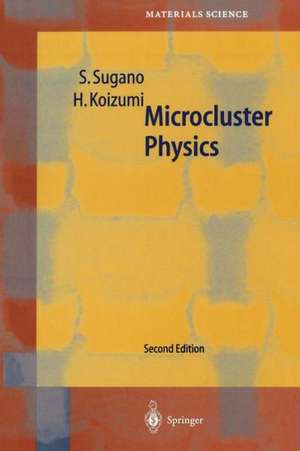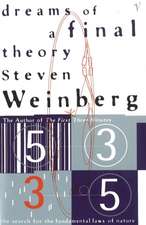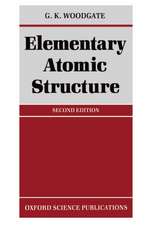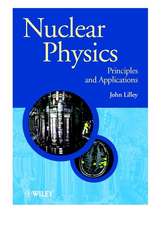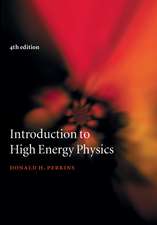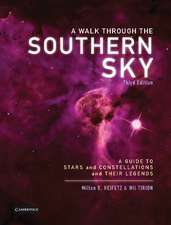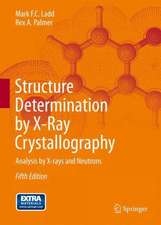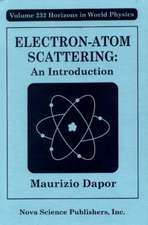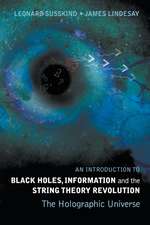Microcluster Physics: Springer Series in Materials Science, cartea 20
Autor Satoru Sugano J. Peter Toennies Autor Hiroyasu Koizumien Limba Engleză Paperback – 16 oct 2012
| Toate formatele și edițiile | Preț | Express |
|---|---|---|
| Paperback (1) | 1105.82 lei 43-57 zile | |
| Springer Berlin, Heidelberg – 16 oct 2012 | 1105.82 lei 43-57 zile | |
| Hardback (1) | 1109.92 lei 43-57 zile | |
| Springer Berlin, Heidelberg – 20 iul 1998 | 1109.92 lei 43-57 zile |
Din seria Springer Series in Materials Science
- 18%
 Preț: 1820.22 lei
Preț: 1820.22 lei - 18%
 Preț: 776.09 lei
Preț: 776.09 lei - 24%
 Preț: 689.68 lei
Preț: 689.68 lei - 18%
 Preț: 968.96 lei
Preț: 968.96 lei - 20%
 Preț: 568.94 lei
Preț: 568.94 lei - 18%
 Preț: 953.65 lei
Preț: 953.65 lei - 18%
 Preț: 902.36 lei
Preț: 902.36 lei - 18%
 Preț: 953.65 lei
Preț: 953.65 lei - 20%
 Preț: 948.41 lei
Preț: 948.41 lei - 18%
 Preț: 1143.07 lei
Preț: 1143.07 lei - 18%
 Preț: 1111.53 lei
Preț: 1111.53 lei - 18%
 Preț: 1103.62 lei
Preț: 1103.62 lei - 18%
 Preț: 1225.94 lei
Preț: 1225.94 lei -
 Preț: 473.91 lei
Preț: 473.91 lei - 18%
 Preț: 782.42 lei
Preț: 782.42 lei -
 Preț: 433.47 lei
Preț: 433.47 lei - 18%
 Preț: 1116.40 lei
Preț: 1116.40 lei - 18%
 Preț: 946.24 lei
Preț: 946.24 lei - 18%
 Preț: 945.20 lei
Preț: 945.20 lei - 15%
 Preț: 641.20 lei
Preț: 641.20 lei - 18%
 Preț: 958.56 lei
Preț: 958.56 lei - 18%
 Preț: 1224.36 lei
Preț: 1224.36 lei - 15%
 Preț: 644.82 lei
Preț: 644.82 lei - 24%
 Preț: 833.43 lei
Preț: 833.43 lei - 24%
 Preț: 1060.33 lei
Preț: 1060.33 lei - 18%
 Preț: 964.10 lei
Preț: 964.10 lei - 18%
 Preț: 1224.36 lei
Preț: 1224.36 lei - 18%
 Preț: 1221.20 lei
Preț: 1221.20 lei - 18%
 Preț: 946.87 lei
Preț: 946.87 lei - 18%
 Preț: 1836.92 lei
Preț: 1836.92 lei - 15%
 Preț: 643.34 lei
Preț: 643.34 lei - 18%
 Preț: 1246.32 lei
Preț: 1246.32 lei - 18%
 Preț: 956.81 lei
Preț: 956.81 lei - 18%
 Preț: 953.52 lei
Preț: 953.52 lei - 15%
 Preț: 637.59 lei
Preț: 637.59 lei - 24%
 Preț: 1060.87 lei
Preț: 1060.87 lei
Preț: 1105.82 lei
Preț vechi: 1348.56 lei
-18% Nou
Puncte Express: 1659
Preț estimativ în valută:
211.59€ • 221.52$ • 175.08£
211.59€ • 221.52$ • 175.08£
Carte tipărită la comandă
Livrare economică 07-21 aprilie
Preluare comenzi: 021 569.72.76
Specificații
ISBN-13: 9783642637933
ISBN-10: 3642637930
Pagini: 252
Ilustrații: XII, 236 p.
Dimensiuni: 155 x 235 x 13 mm
Greutate: 0.36 kg
Ediția:2nd ed. 1998. Softcover reprint of the original 2nd ed. 1998
Editura: Springer Berlin, Heidelberg
Colecția Springer
Seria Springer Series in Materials Science
Locul publicării:Berlin, Heidelberg, Germany
ISBN-10: 3642637930
Pagini: 252
Ilustrații: XII, 236 p.
Dimensiuni: 155 x 235 x 13 mm
Greutate: 0.36 kg
Ediția:2nd ed. 1998. Softcover reprint of the original 2nd ed. 1998
Editura: Springer Berlin, Heidelberg
Colecția Springer
Seria Springer Series in Materials Science
Locul publicării:Berlin, Heidelberg, Germany
Public țintă
ResearchCuprins
1. What are Microclusters?.- 1.1 Constituent Small Particles of Material.- 1.2 Division of the Materials.- 1.3 Shell Periodicity of Atomic Structure.- 2. Dynamics of Atomic Structure.- 2.1 Solid-like, Liquid-like, or Fluctuating?.- 2.2 Coexistence of Solid-like and Liquid-like Phases.- 2.3 Fluctuating States and Permutation Isomers.- 2.4 Monte-Carlo Simulations.- 2.5 Spontaneous Alloying.- 3. Shell Structure of Metal Clusters.- 3.1 Magic Numbers.- 3.2 The Jellium Model.- 3.3 Theory of Shell Correction.- 3.4 Deformation.- 3.5 Fission.- 3.6 Shell Structure in Large Metal Clusters.- 4. Other Properties of Metal Clusters.- 4.1 Non-Empirical Calculation of Alkali-Metal Clusters.- 4.2 Electronic Structure of Noble-Metal Clusters.- 4.3 Magnetic Properties of Transition-Metal Clusters.- 4.4 Oscillatory Magnetic Moments of Nickel Clusters.- 4.5 Divalent-Metal Clusters.- 4.6 Trivalent-Metal Clusters, AlN.- 5. Semiconductor Clusters.- 5.1 Carbon Clusters.- 5.2 Stabilities of Silicon and Germanium Clusters.- 5.3 Nonempirical Calculations for Si6 and Si10.- 5.4 Force and Vidal Analysis of Larger Silicon Clusters.- 5.5 Recent Nonempirical Calculations for Large Silicon Clusters.- 6. Rare-Gas Clusters.- 6.1 The Magic Numbers for Packing.- 6.2 Helium Clusters.- 7. Molecular Clusters.- 7.1 Photoionization of Ammonia Clusters.- 7.2 Ion-Centered Cage Structure.- 7.3 Water Clusters.- 7.4 Negatively Charged Water Clusters.- 7.5 Electron Attachment to van der Waals Clusters.- 8. Chemical Bonds and Related Topics.- 8.1 Effects of Electron Correlation, and the Optimization of Geometry on Magnetism.- 8.2 Synthetic Chemistry in a Cluster Beam.- 8.3 Generation of a Latent Image.- 8.4 Van der Waals and Metallic Mercury Clusters.- 8.5 Scattering of Microclusters.- References.
Textul de pe ultima copertă
Microcluster Physics provides a lucid account of the fundamental physics of all types of microclusters, outlining the dynamics and static properties of this new phase of matter, which is intermediate between a solid and a molecule. Since the original book was published in 1991, the field of microclusters has experienced surprising developments, which are reviewed in this new edition: the determination of atomic structure, spontaneous alloying, the super-shell, fission, fragmentation, evaporation, magnetism, fullerenes, nanotubes, atomic structure of large silicon clusters, superfluidity of He clusters, water clusters in liquid, electron correlation and optimizsation of the geometry, and scattering.
Caracteristici
Update of the 1st edition. - New developments in determination of atomic structure; spontaneous alloying; super-shell; fission, fragmentation, evaporation; magnetism; fullerenes; nanotubes; atomic structure of large silicon clusters; superfluidity of a He cluster; water clusters in liquid; electron correlation and optimization of geometry; scattering.
